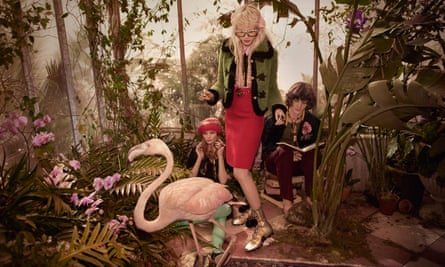The trailer for new movie Birthmarked is a strange thing, both quirky yet teeth-grindingly banal. Over a jingly-jangly soundtrack, Matthew Goode and Toni Collette play a studiously eccentric American couple who choose to bring up their children in studiously eccentric ways. Cue tears, cue laughter, cue a whole Pinterest board full of quirky references. It wants to be The Royal Tenenbaums; it’s more The Durrells, set to the Lumineers.
There is, of course, one man to blame for all this: Wes Anderson. Over two decades, the meticulous Rushmore auteur has helped spawn an entire sub-genre of American cinema, a landfill site chocca with handlebar moustaches, melancholia and tasteful alt-folk music. He has had a boggling influence over the rest of pop culture, too, on fashion, design, pop and social media. It ranges from Gucci’s billion-dollar renaissance, trading on various elements of Tenenbaum-chic, to the recent video for SZA’s Broken Clocks, where the singer and friends cavort in a very Anderson-like US holiday camp. And where there isn’t homage, there is downright parody: see Honest Trailers’ recent send-up on YouTube of “Every Wes Anderson Movie”, savagely roasting the tics of “your barista’s favourite director”. (A voiceover intones: “A Wilson Brother. Strained Sibling Relationships. Exotic Animals. A Wilson Brother and His Estranged Sibling Smoking with an Exotic Animal.”)
All this is to say, we are at peak Wes Anderson – or rather, we have been for a very, very long time. We have to ask: why is this style so easy to send up? And why is it so hard to dislodge? After all, it’s not as though it’s going anywhere: his latest film Isle of Dogs is another critical and commercial hit. The Wes Anderson style – the lovingly curated music, the careful shot composition, the sharp costumes, the incessant references – is easy to copy; or rather, it seems as if it is. Tristan Oliver should know; he was director of photography on Isle of Dogs. “It’s pretty easy to pastiche Wes,” he admits. “I think certainly a lot of commercials are made that way, and in quite a sloppy way; these peculiarly pale, flat commercials with strange childlike adults wearing clothes that are slightly too small for them.”
In short, it’s a style that lends itself way too easily to lazy commercialisation, and has accordingly paid the price. “He’s a victim of how seductive his identity and his aesthetic were, really,” says Danny Leigh, critic and senior curator of fiction at the BFI. “It was there in restaurants, and the designs of book covers, and in shop windows.” Leigh actually thinks we first reached peak Anderson at least 10 years ago, when The Darjeeling Limited was released to a much more muted response. Yet he also concedes that the influence is stronger than ever.

“A lot of modern culture is based around the idea of the carefully curated self-image,” he says. “That’s one thing Anderson helped pioneer: the idea that everything was deeply self-conscious and deeply tailored.”
It should be no surprise, for instance, that the Anderson aesthetic is now all over Instagram. Indeed, some have even suggested that the rise of the artfully shot food photo, beautifully symmetrical and nicely saturated in colour, is a homage to Wes. More explicit is the Instagram account Accidentally Wes Anderson, which seeks out real-life scenes that echo his distinctive style.
“Everything that you see in a Wes Anderson film is typically, for the most part, eye-pleasing in certain ways, be it the symmetry or the colour palette,” confirms Wally Koval, who started the account last summer. “And those are the pieces that grab your attention when you’re flipping through your feed.”
Accidentally, Wes Anderson’s success bears out a very basic fact, one that critics have to concede: a lot of Anderson is very popular because a lot of it is very pleasing. Taste, though, is a tricky thing, and too much of it can seem suspicious or affected. This certainly applies to Anderson, the perceived high priest of hipsterism and twee. Chances are, if you’ve spent the past decade railing against morons drinking cocktails out of jam jars, you have, in part, been railing against him; and that’s not only a set of visual tics but a whole philosophy or ethos, what Leigh calls “that slightly otherworldly, slightly pampered ability to withdraw from the real world”.
This is arguably both Anderson’s greatest charm and flaw. It is a world where, at first glance, neither the film-maker, nor his characters, want to age. Troubled youth and arrested adolescence are among Anderson’s great themes, be that in Rushmore, The Royal Tenenbaums or Isle of Dogs. It’s charming at first but eventually it can tire. Don’t they ever want to grow up? The funny thing is, though, Anderson kind of has. It’s not necessarily by being more political, even if people have found a more serious subtext to Isle of Dogs, with its vivid tale of populism and genocide (albeit doggy-based). What might be more accurate to say is that if Anderson isn’t exactly progressing from film to film, he is certainly deepening his themes. As this decade’s work shows – from Moonrise Kingdom to The Grand Budapest Hotel to Isle of Dogs – he is, on some level, doing it better and better, with more variety and profundity. Ironically, he is also now using the medium of children’s movies to display more adult film-making.
Leigh compares Anderson to David Lynch for two reasons: first, because their style became ubiquitous, and everyone got a bit bored; second, “because it’s the idea that somebody doesn’t evolve in the sense of changing; they just evolve in the sense of becoming more and more themselves”. Gripe all you like about Anderson’s vision but it clearly does go beyond affectation. “I think he’s motivated by something almost beyond what he can verbalise,” says cinematographer Oliver.

But if Anderson will just stay himself, what does everyone else do? Ask Leigh, Koval or Oliver whether they can think of any other new film-maker being quite so influential, on a visual level at least, and each draws a blank. Luca Guadagnino may be the arthouse director du jour, but has Call Me By Your Name spawned more sales of tight swimming shorts or, indeed, peaches?
Oliver actually suggests that Anderson’s work is becoming more, not less, unusual with time. “Wes’s world is one of extreme symmetry and intense detail. People’s attention spans are becoming shorter, and people aren’t really paying attention to detail. So to be forced into a visual environment where you are made to look at things – things that have been crafted beautifully to that man’s vision – is, I think, unusual.”
Leigh, though, manages to flag up two more surprising recent descendants: Lady Bird and Paddington 2. In each case, these films harnessing Andersonian themes speak in their own language, be it the miseries of stylised adolescence, or a hefty dose of sophisticated, Wes-like whimsy. “Paddington 2 just looks and feels like a Wes Anderson film – and that’s a compliment,” he says.
Anyway, what of the man himself? Does all this register? “I don’t think he cares very much what anyone thinks,” says Oliver. “I can remember him saying to me when we worked on Fantastic Mr Fox, when I had suggested something to him: ‘Yeah, that’s the sort of thing we would do if we were making a film that we wanted people to go and see.’”
And if we are all now stuck in Wes’s world, that really isn’t his concern.











Comments (…)
Sign in or create your Guardian account to join the discussion